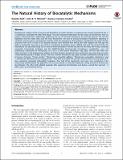The natural history of biocatalytic mechanisms
Abstract
Phylogenomic analysis of the occurrence and abundance of protein domains in proteomes has recently showed that the α/β architecture is probably the oldest fold design. This holds important implications for the origins of biochemistry. Here we explore structure-function relationships addressing the use of chemical mechanisms by ancestral enzymes. We test the hypothesis that the oldest folds used the most mechanisms. We start by tracing biocatalytic mechanisms operating in metabolic enzymes along a phylogenetic timeline of the first appearance of homologous superfamilies of protein domain structures from CATH. A total of 335 enzyme reactions were retrieved from MACiE and were mapped over fold age. We define a mechanistic step type as one of the 51 mechanistic annotations given in MACiE, and each step of each of the 335 mechanisms was described using one or more of these annotations. We find that the first two folds, the P-loop containing nucleotide triphosphate hydrolase and the NAD(P)-binding Rossmann-like homologous superfamilies, were α/β architectures responsible for introducing 35% (18/51) of the known mechanistic step types. We find that these two oldest structures in the phylogenomic analysis of protein domains introduced many mechanistic step types that were later combinatorially spread in catalytic history. The most common mechanistic step types included fundamental building blocks of enzyme chemistry: “Proton transfer,” “Bimolecular nucleophilic addition,” “Bimolecular nucleophilic substitution,” and “Unimolecular elimination by the conjugate base.” They were associated with the most ancestral fold structure typical of P-loop containing nucleotide triphosphate hydrolases. Over half of the mechanistic step types were introduced in the evolutionary timeline before the appearance of structures specific to diversified organisms, during a period of architectural diversification. The other half unfolded gradually after organismal diversification and during a period that spanned ~2 billion years of evolutionary history.
Citation
Nath , N , Mitchell , J B O & Caetano-Anolles , G 2014 , ' The natural history of biocatalytic mechanisms ' , PLoS Computational Biology , vol. 10 , no. 5 , e1003642 . https://doi.org/10.1371/journal.pcbi.1003642
Publication
PLoS Computational Biology
Status
Peer reviewed
ISSN
1553-734XType
Journal article
Description
JBOM and NN thank the Scottish Universities Life Science Alliance (SULSA) http://www.sulsa.ac.uk/ and Scottish Funding Council (SFC) http://www.sfc.ac.uk/ for financial support. JBOM thanks the Biotechnology and Biological Sciences Research Council (BBSRC) http://www.bbsrc.ac.uk/ for financial support through grant BB/I00596X/1 and GCA the National Science Foundation (OISE-1132791) http://www.nsf.gov/ and the United States Department of Agriculture (ILLU-802-909 and ILLU-483-625) http://www.csrees.usda.gov/ for financial support. EaStCHEM http://www.eastchem.ac.uk/ provided access to the ECRF computing facility.Collections
Items in the St Andrews Research Repository are protected by copyright, with all rights reserved, unless otherwise indicated.

